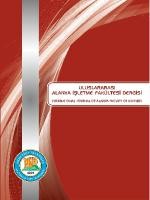Geri Ödemelerin ve Kira Ödemelerinin Parçalı Aritmetik Değişimli Olduğu Ortaklığa Dayalı Konut Finsansmanı Modeli
Günümüzde konut finansman modeli uygulamaları oldukça yaygın olarak kullanılmaktadır. Özellikle konut sahibi olma ve borcunu ödeme durumlarında karşılaşılan zorluklar, konut finansmanı modellerinde farklı ödeme yöntemlerini geliştirme sonucunu doğurmaktadır. Ortaklığa Dayalı Konut Finansmanı Modeli, geri ödemeler ve kira gelirleri ile müşterinin hissesinin arttığı, finansörün hissesinin azaldığı bir finansman modelidir. Ortaklığa Dayalı Konut Finansmanı Modeli’nde, geri ödemeler kişinin gelir düzeyine ve ekonomik yapısına göre her bir dönem için miktarsal ya da oransal farklılıklar göstermektedir. Çeşitli modeller ile elde edilen genel formüller literatürde yer almaktadır. Ancak bazı problemlerin çözümünde bu formüller yetersiz kalmaktadır. Bu çalışmada, Ortaklığa Dayalı Konut Finansmanı Modeli’ndeki bazı varsayımlar genişletilerek geri ödemelerin ve özellikle de kira ödemelerinin parçalı aritmetik eğilimli seri olduğu durumlar için yeni formüller türetilmiştir ve geliştirilen model için sayısal örnek verilmiştir.
Anahtar Kelimeler:
Konut Finansmanı, Ortaklık, Parçalı Aritmetik Değişimli Seriler
Geri Ödemelerin ve Kira Ödemelerinin Parçalı Aritmetik Değişimli Olduğu Ortaklığa Dayalı Konut Finsansmanı Modeli
In today’s world, the applications of home financing models are widely used. In particular, the difficulties encountered in cases of dept payment and home ownership has resulted the development of different payment methods in the home financing models. A home financing model based on partnership is a financing model that while customer’s share is increasing with repayments and rent incomes, the share of financier is reducing. In the Home Financing Model based on partnership, repayments consist of quantity or proportional differences for each term according to person’s level of income and economic structure. General formulae obtained from a variety of models are in the literature. However, the formulas are inadequate to solve some problems. In this study, new formulas are proposed in the case of repayments and especially rent payments are piecewise arithmetic gradient series by developing some of the assumptions of the home financing model. Furthermore, numerical examples and solutions are given for the developed models. 1.
Keywords:
-,
___
- ABIDIN, S.Z., NASSIR, A. Md. and KHODERUN, P. F. F. (2008). “Musharakah Mutanaqisah: A Solution to Different Interpretations by Malaysian and Middle East Scholars in Islamic Financing”, The International Conference on Business and Information (BAI 2008), Seoul, South Korea, July 7-9, http://academic-papers.org/ocs2/session /Papers/C8/514-698-1-RV.doc, 02012.
- EROĞLU, A. ve ÖZDEMİR, G. (2011). “Parçalı Aritmetik Değişimli Geri Ödemelere Sahip Ortaklığa Dayalı Konut Finansman Modeli”, Süleyman Demirel Üniversitesi İktisadi ve İdari Bilimler Fakültesi Dergisi, 16(3): 1-7.
- EROĞLU, A. ve ÖZDEMİR, G. (2012). “Parçalı Gemetrik Değişimli Geri Ödemeler ile Ortaklığa Dayalı Konut Finansman Modeli”, Gazi Üniversitesi Mühendislik ve Mimarlık Fakültesi Dergisi, 27(1): 37-40.
- EROĞLU, A., KALAYCI, Ş., ÖZDEMİR, G. and ÇETİN A. C. (2010). “Generalized Formulae for the Shared Equity Home Financing Model”, Süleyman Demirel Üniversitesi İktisadi ve İdari Bilimler Fakültesi Dergisi, 15(1): 1-10.
- EROĞLU, A., KALAYCI, Ş., ÖZDEMİR, G., ÇETİN A. C. and USUL, H. (2010). “Generalized Formulae for Islamic Home Financing through the Musharakah Mutanaqisah Contracts”, Afro Eurasian Studies, 1(1): 126-133.
- HIJAZI, S. T. and HANIF, M. (2010). “Islamic House Fİnancing: A Critical Analysis and Comparison with Conventional Mortgage”, Middle Eastern Fİnance and Economics, 6, http://papers.ssrn.com/sol3/papers.cfm?abstract_id=1483524, 14.03.2012. MEERA, A. K. M. and RAZAK, D. A. (2005). “Islamic Home Financing Through Musharakah Mutanaqisah and al-Bay’ Bithaman Ajil Contracts: A Comparative Analysis”, Review of Islamic Economics, 9(2):5-30.
- MEERA, A. K. M. and RAZAK, D. A. (2009). “Islamic Home Financing through Musharakah Mutanaqisah Contracts: A Comparative Analysis”, JKAU: Islamic Economics, 22(1):121-143.
- RAMMAL, H. G. (2004). “Financing Through Musharaka: Principles and Application”, Business Quest, http://papers.ssrn.com/sol3/papers.cfm?abstract_id=1442430, 14.03.2012.
- SISWANTORO, D. and OOYYIMAH, H. (2005). “Analysis on the Feasibility Study of Musharakah Mutanaqisah Implementation in Indonesian Islamic Banks”, 6th International Conference on Islamic Economics and Finance, Islamic Economics and Banking in the 21st Century, 1: 87-104, November 21-24. Jakarta, Indonesia, http://islamiccenter.kau.edu.sa/7iecon/Ahdath/Con06/_pdf/Vol1/5%20Dodik%20Siswantoro%20%20Hamidah%20Analysis.pdf, 14.03.2012.
- ISSN: 1309-1522
- Başlangıç: 2015
- Yayıncı: Akdeniz Üniversitesi
Sayıdaki Diğer Makaleler
Merkezi Yönetim-Belediye İlişkileri'nde Antalya Büyükşehir Belediyesi Örneği
Stok Kontrolde ABC Yöntemi ve AHP Analizlerinin İplik İşletmesine Uygulanması
İrfan ERTUĞRUL, Yasemin TANRIVERDİ
Murat ÇUHADAR, Tuncay AYDOĞAN, Hale BAHAR
Grade and Composition of the First Money in Anatolia
Türkiye'de İstihdam-Büyüme İlişkisinin Analizi (1988-2011)
Markov Analizi ile Yıllık Ödeneklere Bağlı Bir Tahmin Uygulaması
Fatıma BÜYÜKTATLI, Sevgi İŞBİLİR, Emre İpekçi ÇETİN
Konut Finansman Sisteminde Coğrafi Bilgi Sistemlerinin Kullanılabilirliği
